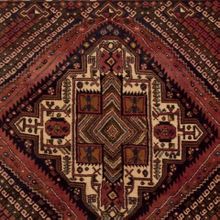Difference between revisions of "Shahr-e-babak Rug"
| Line 35: | Line 35: | ||
|additional info = | |additional info = | ||
}} | }} | ||
| − | From the city of that name in southern Persia, the incredible Kerman carpet is a soft treasure, and among the most beautiful designs woven. The traditional motif has the main border and central medallion in an intricately-detailed, ornate architectural or floral theme in the palest pastels with white-and-gold trim. This typically contrasts with an open field of a rich solid cranberry red, navy blue or other strong colors. Others patterns include the finer Lavar style with garden, tree-of-life, vase and all-over mille fleur designs, or the many pictorials which tell the story of a significant figure or event in history. Silk is almost never used. | + | From the city of that name in southern Persia, the incredible Kerman carpet is a soft treasure, and among the most beautiful designs woven. The traditional motif has the main border and central medallion in an intricately-detailed, ornate architectural or floral theme in the palest pastels with white-and-gold trim. This typically contrasts with an open field of a rich solid cranberry red, navy blue or other strong colors. Others patterns include the finer Lavar style with garden, tree-of-life, vase and all-over mille fleur designs, or the many pictorials which tell the story of a significant figure or event in history. Silk is almost never used. |
| − | |||
<!-- from Rugman Archive:https://web.archive.org/web/20080712080022/http://www.rugman.com:80/AreaRugs/ShahrBabak-AreaRug-1700410035.html --> | <!-- from Rugman Archive:https://web.archive.org/web/20080712080022/http://www.rugman.com:80/AreaRugs/ShahrBabak-AreaRug-1700410035.html --> | ||
| − | + | == History == | |
| + | == Materials == | ||
| + | === Foundation and Pile === | ||
| + | == Techniques and structures == | ||
| + | === Color and dyeing === | ||
| + | === Motifs and Designs === | ||
| + | === Weaving techniques === | ||
| + | == See also == | ||
| + | == References == | ||
| + | {{Reflist}} | ||
| + | == Bibliography == | ||
| + | Abraham Levi Moheban, (2015), ''[[The Encyclopedia of Antique Carpets|The Encyclopedia of Antique Carpets: Twenty-Five Centuries of Weaving]]'', NewYork: Princeton Architectural Press. | ||
[[Category:Persian Rug and Carpet]] | [[Category:Persian Rug and Carpet]] | ||
[[Category:Rug and Carpet]] | [[Category:Rug and Carpet]] | ||
[[fa:قالی_شهربابک]] | [[fa:قالی_شهربابک]] | ||
Revision as of 09:19, 4 December 2019
| Shahr-e-babak Rug | |
|---|---|
 Design of Shahr-e-babak Rug (Rugman) | |
| General information | |
| Name | Shahr-e-babak Rug |
| Original name | قالی شهربابک |
| Alternative name(s) | Shahr-e-babak Carpet |
| Origin | |
| Category | Village |
| Technical information | |
| Common designs | Medallion, Geometric, Vase |
| Common colors | Red, Brown, White, Golden, Blue |
| Dyeing method | Natural, Synthetic |
| Pile material | Wool |
| Foundation material | Cotton |
| Knot type | Asymmetrical (Persian) |
From the city of that name in southern Persia, the incredible Kerman carpet is a soft treasure, and among the most beautiful designs woven. The traditional motif has the main border and central medallion in an intricately-detailed, ornate architectural or floral theme in the palest pastels with white-and-gold trim. This typically contrasts with an open field of a rich solid cranberry red, navy blue or other strong colors. Others patterns include the finer Lavar style with garden, tree-of-life, vase and all-over mille fleur designs, or the many pictorials which tell the story of a significant figure or event in history. Silk is almost never used.
History
Materials
Foundation and Pile
Techniques and structures
Color and dyeing
Motifs and Designs
Weaving techniques
See also
References
Bibliography
Abraham Levi Moheban, (2015), The Encyclopedia of Antique Carpets: Twenty-Five Centuries of Weaving, NewYork: Princeton Architectural Press.